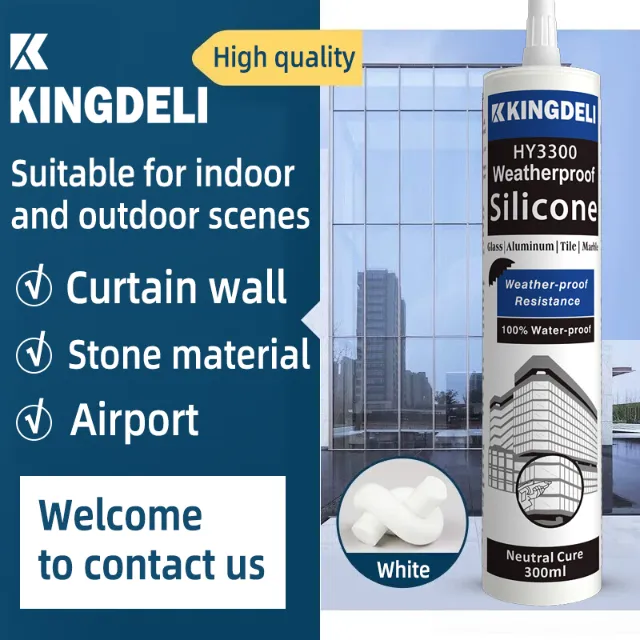Best Sealants for Aluminum Curtain Walls


Introduction
Modern building fronts use curtain wall setups to build clean, tough, and rain proof outsides. Sealants sit at the heart of this. They stop air and water from slipping through, let parts bend a little, and keep things working for years. Pick the right one, and your curtain wall stays safe, saves power, and looks the same for ages.
Aluminum Curtain Wall Systems
What Is an Aluminum Curtain Wall
An aluminum curtain wall works like a thin outer layer on buildings. It hangs from the main frame, almost like cloth on a rod. Workers build it from aluminum bars and fill them with glass or metal sheets. This clever trick blocks wind and rain, yet it carries no real weight from the structure. Cool idea, huh? You get huge windows and fresh styles, all while the building stays rock solid.
Why Sealants Matter in Curtain Wall Design
Sealants plug those small spaces where frames touch panels or glass. They keep rain out during heavy storms. They also stop cold drafts that push up heating costs. And they bend when the building sways from heat or gusts. Skip good sealants, and leaks wreck insides in no time. Think of them as quiet champs that hold the whole thing tight.
Types of Sealants Used in Curtain Walls
Structural Silicone Sealants
These strong silicones stick glass straight onto aluminum frames in structural glazing. They form bonds that last for decades, even under blazing sun or sharp frosts. Their stretch lets buildings move without splits. Perfect for tall towers where safety matters most. A tad costly, yet it beats any breakdown.
Weatherproof Silicone Sealants
Workers put these on outer joints. They fight off rain, sun rays, and urban dirt. They remain soft and leak proof for many years, with no fade or stiff turns. Suited for open spots on high offices or skyscrapers. Builders like them since the job goes smooth. The front stays neat far longer than cheap picks.
By adopting advanced silicone technology, Kingdeli supports architects and installers in creating façades that combine lasting strength with modern aesthetics.
Hybrid and Polyurethane Sealants
Hybrids blend silicone wins with polyurethane grit. They give good pull and let you paint over them easy. Polyurethanes do well in damp zones or when paint must match the wall. They fit inside areas or non glass sections. Not as sun proof as full silicone, though. Choose them for tight budgets or special joint tasks.

Key Properties to Consider When Selecting a Sealant
Adhesion and Compatibility
It must grip hard to aluminum, glass, and any finishes. Try samples first; bad matches peel off quick. Aluminum curtain wall sealant sometimes needs primers for slick spots. Good fit stops future trouble. Wrong ones mean extra work, and that hurts on large sites.
Weather Resistance and UV Stability
Outside use calls for sealants that shrug off sun and storms. UV strength stops yellow tones or brittle breaks. Weatherproof sealant keeps its shade in rough weather. Fading ruins fancy looks. Maker long run tests show which hold up. Avoid the flimsy kinds.
Movement Capability and Flexibility
Buildings shift from hot days, cold nights, or quakes. Sealants with big move ratings, say 50% joint stretch, take it without rips. Silicone sealant for construction leads here. Stiff types fail soon. Look at specs for wind force too. Bend keeps seals whole over years.
Application Techniques for Long Lasting Performance
Correct Joint Design and Backer Rod Use
Joints need room to move, often 1:2 depth to width. Backer rods stuff the gap, set sealant depth, and cut waste. No rod leads to thick blobs that cure odd. Plan joints from day one. Bad ones leak no matter the stuff.
Professional Installation and Curing
Smooth the sealant flat right after you lay it, for tidy edges. Work in calm weather, not too warm or wet. Curing needs days; shield from showers. Pros know the moves, like quick two part blends. Hurried work bubbles or splits. Take it slow, and it pays.
Common Problems and How to Prevent Them
Sealant Cracking or Peeling
Cracks pop from dirty spots or missed primers. Peeling strikes when stuff does not mix well. Grab quality silicone sealant for construction and clean deep. Routine looks catch trouble soon. Mismatched pairs trip up new hands often. Stop it before it starts, beats fixing later.
Air or Water Leakage
Leaks begin with thin layers or poor dry time. Gaps let gusty rain in. Hose test joints after setup. Patch quick with more sealant. Air slips raise power tabs too. Strong prep and full cure block most woes flat.
Uneven Aging or Color Change
Low cost sealants turn yellow in sun or lose give. Go for ones with solid UV guards. Aging shows in blotches, spoils the view. Maker info points to champs. Sea salt speeds it along. Good stuff costs more now, but it lasts.
Selecting the Right Product for Your Project
Factors Based on Building Location and Climate
Hot dry lands need top sun block; wet shores want mold guards. Strong winds ask for super bend sealants. Aluminum curtain wall sealant changes by area. Check local rules as well. Wrong choice flops fast in tough spots. Weather picks the needs each time.
Matching Sealants to Glass or Panel Types
Coated glass calls for set stick types; stone needs no mark kinds. Sealant for glass and aluminum bonding must hold without bites. Lab checks prove matches. Bad fits stain or split. Always test on real parts. Saves heaps on fixes.
In many large façade projects, contractors rely on Kingdeli’s structural and weatherproof sealant lines, which offer high adhesion strength, UV resistance, and proven compatibility with glass, stone, and coated panels.
Conclusion
Picking the best sealant for aluminum curtain walls means weighing grip, toughness, bend, and neat looks. Solid stuff plus right steps give the system long guard against weather and building stress. With years of formulation expertise, Kingdeli continues to develop high performance sealant solutions that meet the evolving needs of architectural construction worldwide.
FAQ
Q: What makes silicone the top choice for aluminum curtain wall sealant?
A: Silicone handles UV, weather, and movement better than most. It bonds strong to glass and aluminum without failing over time.
Q: How often should weatherproof sealant be inspected?
A: Check every 5 years or after big storms. Look for cracks or leaks early.
Q: Can hybrid sealants replace silicone sealant for construction?
A: Sometimes, for interiors or paintable spots. But pure silicone wins outdoors for durability.
Q: Is sealant for glass and aluminum bonding hard to apply?
A: Not with pros. Clean surfaces, use backer rods, and cure right. DIY risks leaks.
Q: Do all sealants work in cold climates?
A: No. Pick low temp flexible ones to avoid brittleness in freezes.
